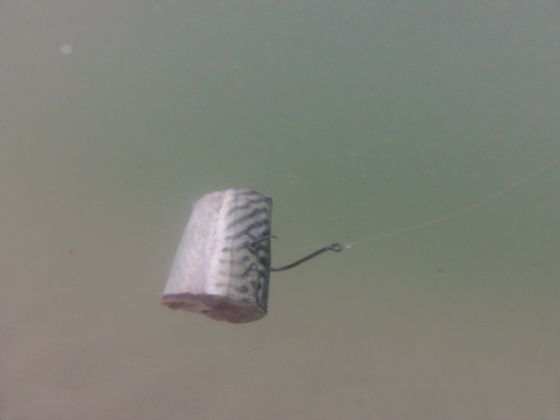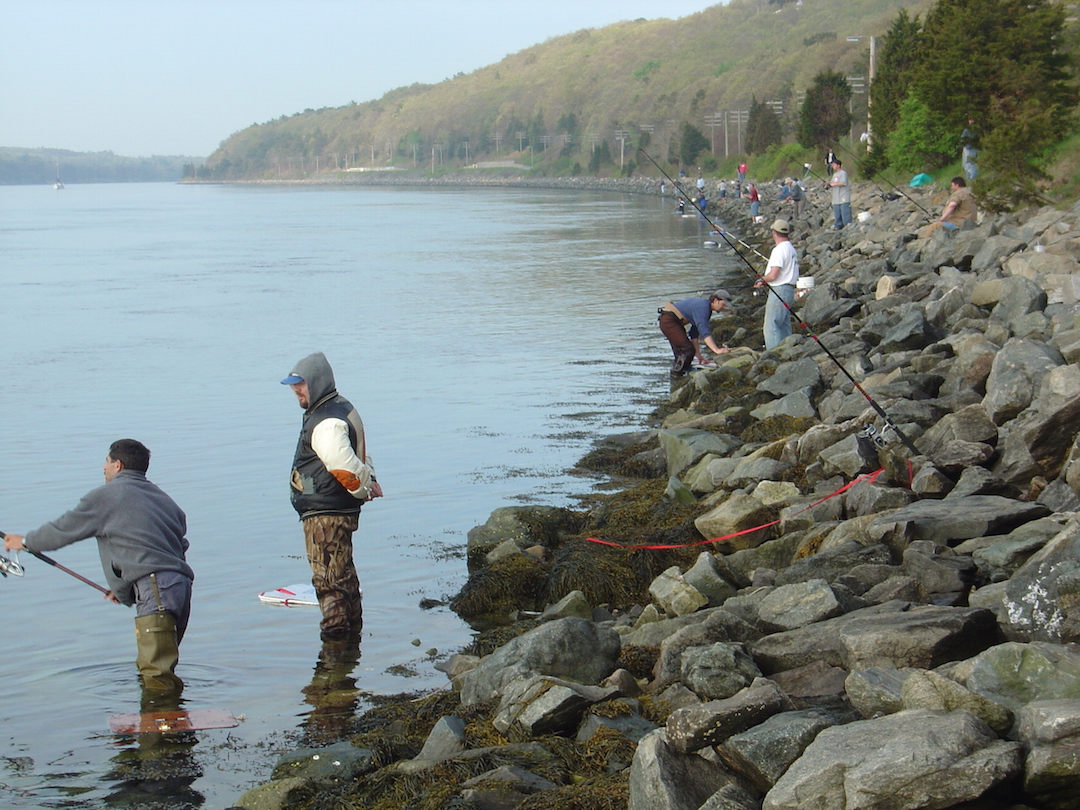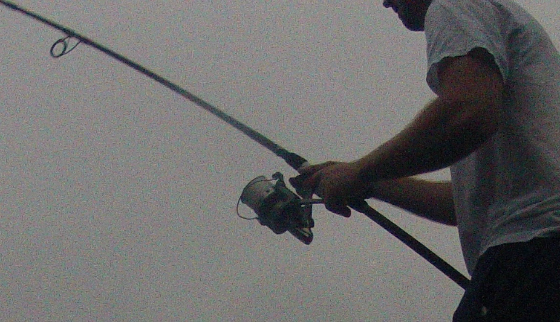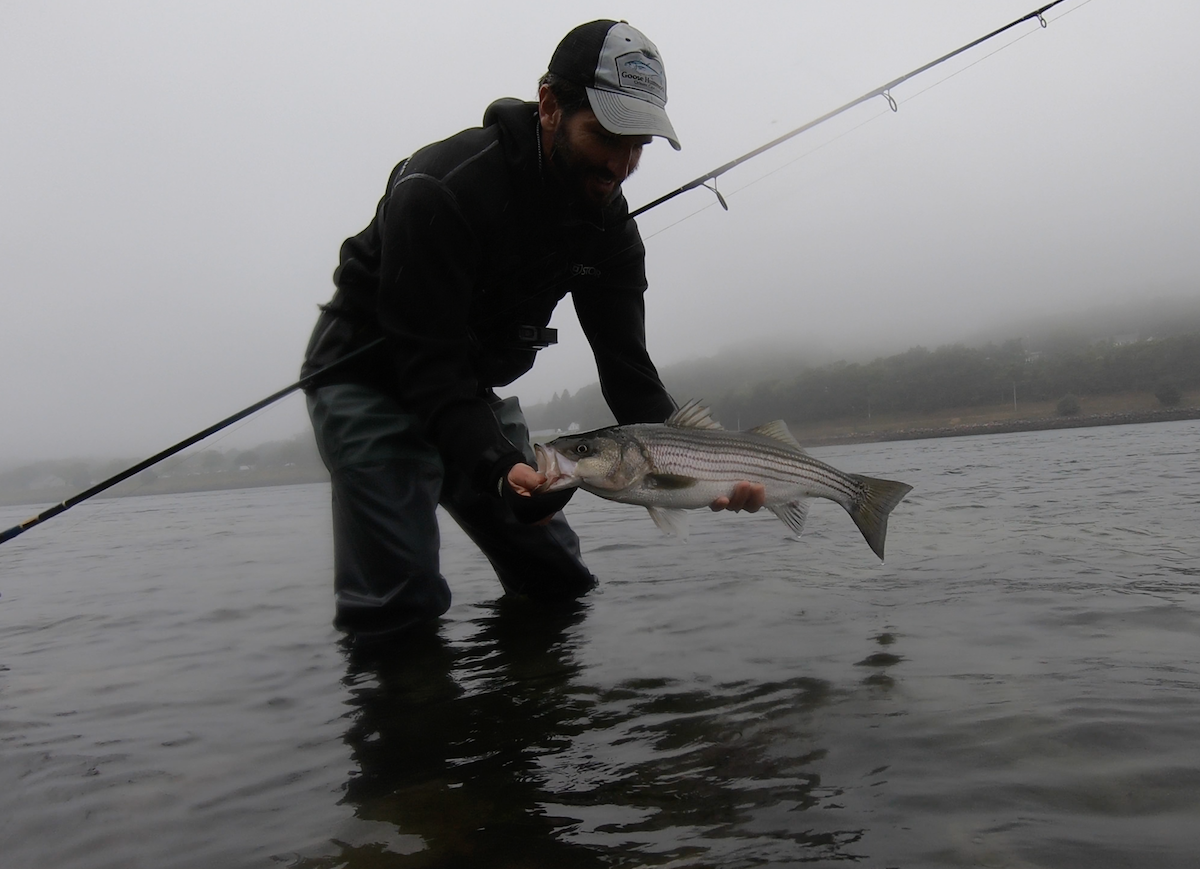Lately I’ve been talking with many people who fish the Cape Cod Canal. Some are beginners while others have decades of Canal fishing experience.
Throughout these conversations I’ve noticed several little things that are yielding big results for beginners and experienced folks alike. I wanted to share those little things that are working for these people (and me too!) with you today.
Let’s dive right in…
1. Drift Bait Instead Of Holding Bottom

Last summer I took a mid-afternoon walk down at the Canal. There on the rip-rap was a group of guys all trying to fish seaworms on the bottom using a heavy weight. Almost instantly they all got snagged and stuck on the bottom. Swear words and frustrated faces ensued.
Without a doubt the easiest way to get snagged on the bottom of the Canal is to cast out a heavy weight and bait, and try to fish that bait stationery on the bottom. This technique works fine on a sandy beach or from a boat, but at the Canal the swift current will quickly bury your bait into the rocks-resulting in a snag.
A better way to fish bait at the Canal is to allow the bait to drift with the current. Sometimes you do not even need any weight. If you do want to fish lower in the water column, try adding a rubber core sinker. Start with a quarter of an ounce and incrementally increase the weight until you find the sweet spot.
You still can fish a stationery bait on the bottom at the Canal, just be sure to try this technique during slack tide. Slack tide is the short window of little current in between tide changes. At this time the current is not very strong, so you will have a much easier time holding bottom.
Click here to learn how to understand Cape Cod Canal tides.
2. Don’t Get “High Strung” When Landing A Fish
Back when I was 14 years old I hooked up with a 30 inch bass while fishing the beach. I was excited as it was the first hook up of the day for me. In my haste I landed the fish with my rod tip pointing straight up to the clouds, at a 90 degree angle to the beach.
A second later and the bass began thrashing in the water. Due to the angle at which I was holding my rod, the rod tip was violently jerked downward, instantly snapping it off.
I learned an important lesson that day on the beach-always keep your rod low when landing a fish. This is especially true at the Canal.
When you attempt to land a nice bass from the Big Ditch, be sure to not hold your rod pointing high to the heavens. The physics involved will snap your rod tip, if the bass at your boots decides to make one last ditch dive to the bottom of the Canal.
This is called getting “high strung” and it is the #1 most common cause of broken rods at the Cape Cod Canal.
3. Understand How To Fish In A Crowd

I like to give other anglers as much room as possible. However, sometimes it is just too busy at the Canal and you have no choice but to snuggle in next to someone…or someone else snuggles in next to you.
When fishing in a crowd it is important to not use a different technique than everyone else. For example, if everyone next to you is topwater plugging, then you shouldn’t be jigging or fishing bait. Doing so would only cause tangles and other issues for those around you.
Always allow the down-current angler to cast first. The down-current angler will cast their lure up-current, and the lure will probably plop down somewhere directly in front of you. Wait for their lure to pass by and then cast your offering up-current. Keep the rotation going in this fashion and don’t cast out of turn because that could cause a tangle.
If you do hook up with a big fish that is screaming line, let the guys down-current of you know what’s going on. Don’t scream at them like a wild man but instead just give them a friendly heads up. Then calmly walk down the rip-rap until you are past them. This way you will be out of their way and the anglers can continue fishing.
Reel in your line when someone near to you hooks up with a fish. Definitely do not cast over someone’s line when they are fighting a good one. I understand that in the heat of the moment this might be hard to do, but there is no excuse for fouling someone else’s line when they have a fish on.
Click here to download a free report on “Must Know Cape Cod Canal Etiquette”
4. Check Your Rod Guides & Bail

One day in my early twenties I headed down to the Canal with a brand new spinning reel. There were a few fish breaking in the middle of the Canal so I decided to really lay into a cast and try to reach the surface activity some 200 plus feet away.
Then I heard what sounded link a gunshot, and watched as my expensive pencil popper sailed 3/4 of the way across the Big Ditch. The bail of my reel had flipped over mid-cast, which when using braided line, always results in the plug snapping off.
Since then I have learned to only use a spinning reel that has a bail locking mechanism. This prevents the bail from flipping over mid-cast, which can happen quite often. I once lost 3 plugs in 7 casts due to this issue!
You also want to check your rod guides every once in a while, especially if you use a swivel to connect your main line to your leader. If you happen to real the swivel into the rod guides, or if you drop your rod onto the rocks, small fractures can develop on your rod guides.
Eventually the braid will get caught in one of these cracks, fraying the braid and diminishing its strength. If the braid does not snap immediately, it may snap the next time the line is put under pressure (like when you hook up with a really nice fish).
If your eyes have trouble seeing such small cracks and fractures, consider pushing a cotton ball through the rod guides and observing if any of the cotton catches on any nicks, cracks or dents.
5. Know When To Call It Quits

During the 2013 season there was one weekend at the Canal when the bass came through in droves. It was an all-out blitz, and it happened to occur on one of the busiest tourism days of the entire summer.
The Canal was packed shoulder to shoulder with fishermen. As the bass moved through the Canal from west to east just about everyone and their grandma started hooking up. It was an epic day of fishing.
Yet from the perspective of the fish, the decision to feed heavily on a day when the Canal was packed with anglers proved to be catastrophic. Hundreds of bass were killed for food or released injured.
Throughout my fishing career I have killed many bass for food, and injured countless more by practicing catch and release. Last year I decided to start “calling it quits” a lot more often, after catching just one or two nice fish on a trip. I placed more emphasis on being content with catching a couple fish, instead of trying to catch as many stripers as possible.
The result was less injured striped bass, and a more relaxed, calm and content Ryan Collins. It felt good to fish, and it also felt good not to fish, and simply play witness to the feeding frenzy around me.
What do you think? Let me know by commenting below.
Tight lines!





Good morning great primer on how to attack fishing the big ditch . Drifting or chunking as some call it is one of the best ways to actually learn how to fish the canal it itself . You cut a piece of bait [at an angle] insert a circle hook and depending on where you are and when you are in the current change, depends upon if you have a rubber core weight from 1/4 ounce to one ounce attached. Simply flip the bait out [shorter rods are better for this application] 7 to 9 feet with some back bone. Allow the bait to follow in the current change and find a spot where the bait will no longer be drifting [Look for swirls and back eddies in the water and try to set up along the edges . Chumming can be critical for this application , that is ladle out in short spurts and you flip the hooked bait right in the middle of it. iT GOES WITH OUT SAYING USING THE HEADS will get you larger fish , leave some meat on the head. Where you place the hook and it needs to be large enough for the size head you are using depends upon your experiences [I like just through the lower and upper jaw and let it hang. The tail section is next [remove the tail fin ] and hook on the narrow end one time. What is left over from the middle gets cut up for the chum [in small pieces] Once you get the hang of things if there is any fish hiding at the bottom of the back current you should be tight with a nice fish. Peace and Prayers
Great information, only thing is on the part know when to quit I’ve read other post when you mentioned how many fish you caught at a certain time and it was more than several.
Yes I’m my own best hypocrite at times! LOL
Thanks for reading and I’m glad you enjoyed the post.
Glad u sent this reminder like I said before it’s a great read. Floating a bait is much more natural presentation. thx
great read thx
My pleasure Greg. Gluck at the canal this summer!
Great Article Ryan!!
Thanks!!
My pleasure George. Glad you enjoyed it!
Ryan – Great call! We all need to be better stewards of the fishery and call it quits more often. The fish will thank us and there will be more fish for us and future generations to enjoy.
Well said Gretchen. Thank you!
About your article on tips for fishing the canal…..I learned about drifting bait from a fishing friend and now I never use sinkers when I fish off the jetty near my house. Most of the time I use whole Squid, but I’ve used Chunk Pogies too.
Nelson
Thanks Nelson! I appreciate the message and the info. Gluck if you make it down to the canal this week.
Thank you Nelson for sharing. I actually caught a beautiful 37 or so incher from the beach last week on a whole dead squid fished without weight!
How do you fish the tide at the Bourne canal? Best tide? Thanks Bob
Check out our Canal eCourse. It has loads of helpful information.
https://myfishingcapecod.com/cape-cod-canal-ecourse/
Tight lines Bob!
Hey Ryan I love your idea of drifting-bait ! I’m down here in NYC fishing the East River, we mostly fish the bottom and lose a lot of rigs stuck on rocks and remnants of the Industrial Age. I’m going to try it with bunker chunks when I’m by myself on the Pier. By the way, I fished on Sunday and there was no life in the water yet ! Thanks, Dennis
Keep us posted with how things work out Dennis! Hopefully drifting chunks will produce a few bites for you.
Definitely keep us posted when you start finding signs of life down your way. Shouldn’t be long now!
Great you helping fisherman – I am coming from SC to fish the Bourne canal in July, any tips for July?
I’m not the best fisherman in the world but I do love to fish. Personally I think for at least three years or even longer. No stripers should be caught until after they drop their roe. Then have at it. Besides, Cape Cod what
a great place to be and just toss the line.
dave b
There is certainly nothing wrong with being extra cautious with the little young fish. Like you mention Dave, it’s just a nice place to be and toss a line.
Well said.
What do I think? Marry that girl Ryan…. I cant get through your website without being jealous of u. Todd
lol – I’m starting to hear the marriage thing more and more often Todd….
I read the entire article. Well written and very informative , most of this info will be put to good use as I am fairly new to ” canal ” fishing.
Sounds great Walt. Be sure to let us know how you make out this season.
Always a good read !! Can’t wait for the next one . do you have any advice for sandy neck beach
Thanks Adam – I appreciate it!
As for Sandy Neck, watch out for piping plovers! And don’t be afraid to toss out a big chunk of mackerel – or even better- an entire freshly dead mac…
Thanks Ryan, good tips to know, this will be my first spring at the canal and I’m not used to fishing around a lot of people. I hear the canal can be particularly biussy in the spring, are there any ways to beat the crowds? (Night fishing, bad weather?) I’m also restricted to weekends unfortunately
I am glad you found the post helpful Brian. The popularity of the Canal has increased in the past 10 years, and it can get busy, especially during Holidays and on the weekends.
To find open space, think of times when people are not likely to be fishing (bad weather, like you mentioned) and make it a priority to go then.
Of course, life often seems to get in the way – I just go whenever I can 🙂
Ryan,
I couldn’t agree with you more on #5. If I’m looking for a fish to take home (yes, I’m one of those that do) when I get one, I’m done. If that’s in the first five minutes, I’m done. If it’s blues, I’ll try to get two or three within a half hour span. It’s not always about the slaughter. And it’s not always about catching a fish at all. It’s beautiful out there, take it in, relax.
Re: #3 How to fish In a Crowd. My rule is simple: Don’t.
Great article.
I think you and I are on the same page Glenn which is very cool. I also like your personal “fishing in a crowd” rule-LOL
I just checked out the SeaView lures Facebook page (https://www.facebook.com/seaview.lures)
Is that all hand carved work? Impressive.
Ryan, the 5 tips were very informative, but to me, the only one specific to the canal was #1. The other four tips (#2 – #5) can apply to almost any fishing location or situation, but it’s always good to reinforce the things fisherman seem to take for granted.
Thanks Don, as you mention the tips can definitely apply to many other situations.
For example, the “high strung” tip is particularly important when fishing from a boat….at least on my boat LOL
Always a pleasure reading, keep up the great work. Tight lines
Thanks Mark I really appreciate it.
Hi Ryan,
Thanks for the tips. In several of your articles you have mentioned the problem of having the bail on your reel flip over in mid cast and snap your line. A long time ago I learned a simple technique to prevent this although I can’t remember where or from whom. As you reel the line in, stop with the middle of the bail towards the rod. Then as you open the bail to make the cast you will be moving the bail away from the rod. This will keep the line away from the bail as you hold it against the rod with your finger as you prepare to cast. As you cast, the line will not touch the bail as it goes out, keeping the bail open throughout the cast. If you allow the line to bump or press against the open bail, it will often cause the bail to close during the cast. – Dex
Hey Dex – It’s been such a frustrating issue for many people…myself included.
Thank you for sharing the tip! I really appreciate it.
A couple years ago I was fishing by myself on a stretch on the Canal that had hardly anyone else on it. It’s a productive spot for me on the right tide and I fish it frequently with an SP Minnow. I watched a guy come down out of the woods towards me and he yells..:”Hey, get off that rock…thats where I fish!!!”…I thought he was kidding until he got closer and closer to me. Next thing I know he’s standing no more than 6 ft from me and he starts casts out with a heavy weight and a chunk.When I fish an SP fish an SP, I “fan” the entire area in front of me looking for a taker. There really wasn’t anybody else within hearing range, and I thought about tossing him in….CC Canal novice.
LOL oh boy that must of been a scene Bill.
Maybe he had just come from the bar?
great thoughts, thank you for sending. I’ve been fishing the canal for a few years and haven’t had the best of luck but your webcasts/articles and emails certainly are giving me a better feel for the upcoming season. am going to use the cotton ball idea since my eyes are failing as I’m getting, a little, older. never have used bait, I think that’s the number one thing I’m going to change this year. thank you!
Hey no worries Jim, I’m happy you are enjoying all the content. I think 2014 will be a great season for all of us here on the site.
The cotton ball trick is a good one! Keep us posted on how things progress for you this year.
Thanks for chiming in!
Nice post ryan, good iming too.the courteous approach to dropping into the lineup is the most important thing a newcomer can learn. As shore bound anglers we are at a disadvantage from the start so working together in crowded conditions is crucial to our success and mental well being. Casting in a rotation is the time honored method of helping everyone keep their cool, also once in the rotation it isn’t mandatory to make every cast! If you have to clear some weed or a tip wrap or you just want to take a blow just sit that rotation out and wait for the next go round. A quick nod or wave to the angler up tide lets them know not to wait for you. Next to keeping your trap shut and ears open this is the fastest way to lose that outsider status.-art.
Hey Art – I can tell you have plenty of experience fishing in a crowd. Thanks a lot for sharing your tips, I think they are spot on.
Like you say, courtesy goes a long way…in fishing and in life.
Yes unfortunatately fishing in crowds is a way of life around here. It’s one of the reasons I enjoy the cape and the vineyard so much. But I haven’t seen the canal at its finest yet. L.o.l.